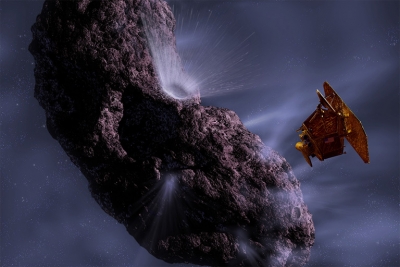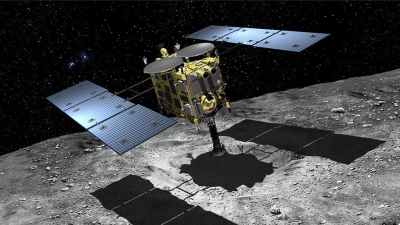
In 1990, the Galileo space probe began to investigate Earth. It was determining whether it is possible to detect signs of life on a planet when viewed from space. The probe detected that Earth had water on its surface and oxygen in its atmosphere, which told scientists that the planet contained life. As well as this, Earth at night is like a glowing neon signpost, alerting aliens to our whereabouts. The Pioneer space probes had special plates engraved with symbols in case the probes ever encountered intelligent life on their journeys into space.
On December 8, 1990, the spacecraft Galileo swept by the Earth, picking up a gravity assist for its long journey to Jupiter. As it came within 960 kilometers of its home planet Galileo was wide awake, all its instruments active, taking measurements and collecting data. For the first time Earth was viewed and measured just like any other planet in the solar system, from the perspective of a spacecraft fly-by.
What could a spacecraft learn about our planet in such a brief visit? Would it detect the things we consider most significant about it – its rich vegetation, teaming life, and human presence? When in 1993 Carl Sagan, co-founder of The Planetary Society, published an article with colleagues in Science magazine about Galileo’s Earth encounter, these were precisely the questions he was trying to address. To their satisfaction, Sagan and his collaborators found that the evidence for the presence of life, and even intelligent life, was plentiful in Galileo’s data. No probe passing by Earth would miss the fact that here was a planet worthy of a more sustained investigation.
The signs of Earthly life picked up by Galileo were numerous: the combination of abundant water on the surface with unusual amounts of oxygen, methane and ozone in the atmosphere, radio signals, and more. One particular indicator that caught Sagan’s attention was the strong reflection of the near-infrared color in the Earth’s spectrum. This “red edge,” he wrote, pointed to the presence of “a light-harvesting pigment in a photosynthetic system.” It was, simply put, the signature of the green plant life that covers vast swathes of Earth’s surface, and it was strongest in those regions of the Earth that are covered with dense vegetation. A probe like Galileo, flying by an unknown planet, would be sure to detect this unmistakable indicator of rich plant life.
The time will probably come when; Star Trek-like, manmade probes will swoop by distant planets and collect data just as Galileo did for Earth. In the present, however, with our limited means and technology, no such close-range encounters are possible. For the foreseeable future, if life-bearing planets are to be found anywhere in the galaxy, they will have to be detected from distances measured by light years, not kilometers. Under such conditions, will the spectral indicator proposed by Sagan and his colleagues be of any use? Will we, in other words, be able to detect that “red edge” in the spectrum of a distant planet, and deduce from it the presence of plant life?
The question is of enormous interest to contemporary astronomers and planetary scientists. So far, admittedly, no Earth-sized planets have as yet been discovered, not to mention imaged, outside our solar system. But the day is undoubtedly near when the sensitivity of the extrasolar planet search will increase to the point when such planets will be found. A new generation of space missions, including the Space Interferometry Mission (SIM), the Terrestrial Planet Finder (TPF), and Darwin, are designed specifically for that purpose – to detect and observe Earth-like extrasolar planets. Within the coming years scientists will be in possession of spectrum measurements, and perhaps images, of distant planets with a mass and orbit comparable to Earth.
When this data becomes available, scientists will immediately begin mining it for signs of distant life. The most obvious and easy to detect signature of life, explains astronomer Pilar Montanes-Rodriguez of the Big Bear Solar Observatory (BBSO) in California, is the presence of large amounts of gases in a planet’s atmosphere than can coexist together only because life is sustaining them. Oxygen and methane, or oxygen, water, ozone and carbon dioxide, are examples of such combinations.
But this in itself only points to the presence of simple microbial life, such as existed on Earth for billions of years before the emergence of multicellular organisms. Detecting complex life, such as plants, is much more difficult, she explains, and for that scientists will need to rely on subtle indicators such as the “red edge.” How should we look for these signs of complex life on distant planets, and how likely are we to find them? These are the questions that Montanes-Rodriguez and her BBSO colleague, Enric Palle, set out to answer.




 As well as receiving signals from outer space, radio telescopes such as Arecibo can also broadcast signals to the entire galaxy and beyond. In 1974, radio waves beamed from the Arecibo telescope carried a message deep into space. The message consisted of 1679 pulses that, when arranged into a grid 23 columns wide and 73 rows tall. The message was aimed at a dense ball of stars called M 13, which is so far away from Earth that it could take up to 50,000 years for a possible reply.
As well as receiving signals from outer space, radio telescopes such as Arecibo can also broadcast signals to the entire galaxy and beyond. In 1974, radio waves beamed from the Arecibo telescope carried a message deep into space. The message consisted of 1679 pulses that, when arranged into a grid 23 columns wide and 73 rows tall. The message was aimed at a dense ball of stars called M 13, which is so far away from Earth that it could take up to 50,000 years for a possible reply. Radio astronomy is the most effective way to search for alien life. Radio telescopes can be positioned all over the world — as radio waves are not affected by the Earth’s atmosphere, and can pick up signals from across the Universe. Radio telescopes such as Arecibo in Puerto Rico, and the Very Large Array, enable astronomers to view space in all directions for signs of alien intelligence.
Radio astronomy is the most effective way to search for alien life. Radio telescopes can be positioned all over the world — as radio waves are not affected by the Earth’s atmosphere, and can pick up signals from across the Universe. Radio telescopes such as Arecibo in Puerto Rico, and the Very Large Array, enable astronomers to view space in all directions for signs of alien intelligence.